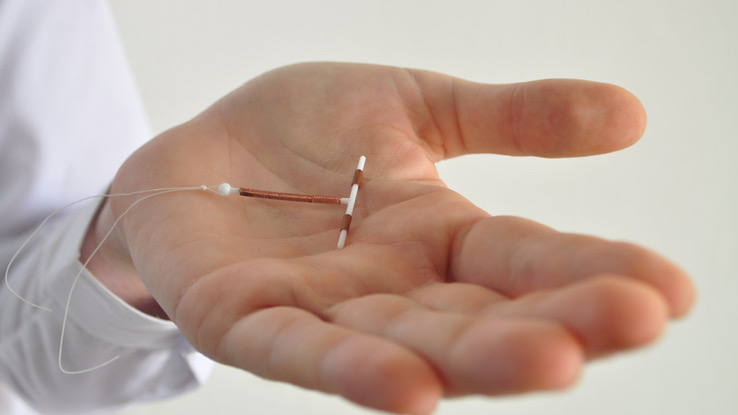Can I Have Iud Again After Removal

An intrauterine device (IUD) is a form of birth control. It is a small-scale flexible plastic device in the shape of a T that a doctor puts inside the uterus (womb) to prevent pregnancy. Read on to larn more than almost an intrauterine device (IUD).
Types of Intrauterine Devices (IUDs)
At that place are two dissimilar types of IUDs available for use: copper and hormonal IUDs.
Copper IUDs
Copper IUDs are wrapped in a small length of copper wire. The copper releases ions that are toxic to sperm and eggs simply are unharmful to the residuum of your body, making it more difficult for the sperm to survive in the environs and for fertilization of the egg to occur. Copper IUDs are 99% effective in preventing pregnancy and last for up to 12 years.Paragard is the simply brand of copper IUD that is FDA approved for use in the US.
Hormonal IUDs
Hormonal IUDs are likewise known as an intrauterine system or IUS. A hormone called progestin coats them and blocks the sperm from reaching the egg to fertilize it. Information technology can also sometimes forestall the release of an egg during your monthly cycle (ovulation). Hormonal IUDs are 99% effective in preventing pregnancy and last between 3 and 7 years, depending on the make (Skyla, Kyleena, Liletta, and Mirena).
Benefits of Intrauterine Devices (IUDs)
IUDs are an first-class option every bit a birth control method because they are:
- 99% constructive at preventing pregnancy — Fewer than i out of every 100 people using an IUD volition have an adventitious pregnancy. An IUD is likewise one of the nearly effective ways to foreclose pregnancy after having sexual practice. You tin get it within 5 days of having unprotected sex activity, and even so exist more than 99% effective.
- Long-lasting — In one case yous get an IUD, an IUD volition work for several years. It can work for up to 7 years for hormonal IUDs and 12 years for copper IUDs.
- Reversible — A doctor or nurse can remove the device at any time, and your chances of getting pregnant volition return to normal.
- Piece of cake to use and depression-maintenance — You tin can get an IUD at any fourth dimension during your menstrual bicycle, and in that location is minimal effort on your office. All you lot need to do is check the thread each calendar month following your period to ensure the IUD is still correctly in identify. Your doctor or nurse volition teach you how to check this. Other than that, you can set it and forget it, which is handy if you don't always remember with other birth control methods. It does non crave partner participation, and so you don't demand to interrupt sex for contraception purposes. Even so, it is important to know that an IUD does not protect against sexually transmitted infections (STIs). So information technology is recommended that yous likewise employ a safe, specially if you are having sex activity with dissimilar people.
In addition, an IUD may be a better selection for y'all than other nascency command methods if you lot:
- Are breastfeeding — IUDs are safety to use while breastfeeding equally they do non affect the quality or quantity of milk product.
- Are taking medications regularly — No medication stops an IUD from effectively preventing pregnancy. The IUD is too unlikely to interact with the outcome of your other medicines.
- Have difficulty taking the hormone estrogen — IUDs practice not contain estrogen. Therefore, they do not carry whatever take a chance of side effects — like acne, bloating, chest tenderness, nausea, or headaches — that some people experience when taking the combined pill or using the vaginal ring containing estrogen.
- Want lighter periods – Many users of the hormonal IUD detect decreased menstrual haemorrhage after a few months, sometimes leading to no vaginal haemorrhage at all. Others may continue to accept a light regular period that is less painful than earlier.
Disadvantages or Possible Side Effects of Intrauterine Devices (IUDs)
Like other birth control, using an IUD as contraception has some disadvantages and side furnishings. The main drawback is that information technology does not protect against STIs, so you may still need to use condoms.
Changes to your period are the nigh mutual side effects of an IUD. This can exist different for each person and depending on the type of IUD, merely you may experience:
- Irregular bleeding, including spotting between periods, for the first 3-6 months. Subsequently this time, your regular haemorrhage pattern normally returns.
- Heavier, longer, or more painful periods for the first 3-half dozen months— commonly with copper IUDs.
- Lighter and shorter periods, or no periods at all after 6 months— with some hormonal IUDs)
- Premenstrual syndrome (PMS)-like symptoms such as moodiness, headaches, acne, and breast tenderness— with some hormonal IUDs
The more serious simply rare risks of using an IUD include:
- Rejection — it is possible that your body may push out the IUD, or information technology may move out of place. This is unlikely, but if it does happen, you may get pregnant. If yous can no longer feel the threads or recall the device has moved, see your doctor once again to have it checked out.
- Pelvic infection — In the showtime month of having an IUD, there is a small run a risk of infection (around 1 in 300). Continue an eye out for any pain or tenderness in your lower abdomen, high body temperature, or an abnormal or smelly discharge. This could exist a sign of infection. See your doctor immediately; they can prescribe antibiotics for handling.
- Perforation of the uterine wall —In extremely rare cases (~0.i%), an IUD tin can poke through (or perforate) the wall of your cervix or uterus. If this happens, y'all will likely need to take the device removed surgically, which tin can carry additional risks.
- Ectopic pregnancy — IUDs forbid 99% of pregnancies; yet, if you get pregnant with an IUD in place, it is more probable to be an ectopic pregnancy. An ectopic pregnancy is when the fertilized egg implants in 1 of the fallopian tubes rather than inside the womb as normal. This state of affairs is fatal for the fetus and tin can exist very dangerous for the mother, so you must go treatment urgently.
How To Get an Intrauterine Device (IUD)

A doctor places the IUD. As long as you are not meaning, y'all tin can go an IUD at any time during your menstrual bicycle. A copper IUD will be constructive immediately afterwards insertion. For the hormonal IUD, it will be effective against pregnancy straight away if placed within the outset seven days of your bike. If you get an IUD at whatever other fourth dimension, you will need to employ boosted contraception for at to the lowest degree a calendar week to ensure you are protected.
If you think you would like to get an IUD, volume an engagement with your doc or local health dispensary to discuss it. They will ask you about your medical history, including questions about your menstrual wheel, sex, and any previous health problems. This is because an IUD may not be suitable for you if are pregnant or if you have:
- An STI that requires treatment
- Bleeding between periods or later sex
- Any other problems with your cervix or uterus
Intrauterine Device (IUD) Procedure
The entire appointment for placing an IUD takes effectually 20-30 minutes, and the actual fitting of the device should only take a few minutes from start to finish. The procedure is quite similar if you have ever had a pap smear (cervical screen test). Here is what you lot tin can look:
- Your doctor or nurse will inquire you to undress from the waist down and lie back on the bed with your legs aptitude at the knee and held slightly apart.
- They will and then insert a metal or plastic device called a speculum into your vagina to hold it open.
- The IUD is then put inside an applicator tube (similar to a tampon applicator) and inserted into your cervical canal to place the IUD into your uterus advisedly.
- Afterward the doc removes the application tube, the IUD remains in identify. It has very fine strings fastened to it, which hang down through the cervix.
- Your doctor or nurse will then trim the strings, so they don't hang downwardly also low. If yous felt inside your vagina, y'all would exist able to check that the thread is still there and the IUD is still in identify.
Getting an IUD tin be uncomfortable. Most people will likely experience balmy cramping during the placement that lasts briefly and gets ameliorate within a few minutes. Some people may notice it more painful than others. Let your dr. know if you lot experience any hurting or discomfort — and remember you can ask them to stop.
The cost of getting an IUD depends on the type of IUD, your healthcare provider, and your insurance coverage. Bank check whether your health insurance plan covers birth command and up to what amount. You may also be eligible for costless or low-cost IUDs through Authorities Programs or family unit planning clinics such equally Planned Parenthood.
Resources Links
- "IUD" via Planned Parenthood
- "Intrauterine Device" via StatPearls
- "Intrauterine device (IUD)" via Coronavirus (COVID-xix)
- "Contraception – intrauterine devices (IUD)" via Better Wellness Channel
- "Exercise the Benefits of an IUD Outweigh the Potential Side Effects?" via Cleveland Dispensary
Source: https://www.symptomfind.com/healthy-living/what-is-an-intrauterine-device-iud-and-how-does-it-work?utm_content=params%3Ao%3D740013%26ad%3DdirN%26qo%3DserpIndex
Postar um comentário for "Can I Have Iud Again After Removal"